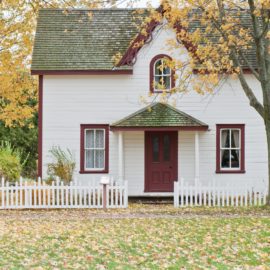
Why are our homes designed the way they are? What can the average house tell us about human history?
Bill Bryson’s At Home: A Short History of Private Life reveals how our houses serve as fascinating time capsules of human development. By examining everything from room layouts to household technologies, Bryson shows how homes reflect centuries of human innovation, cultural shifts, and daily life patterns.
Keep reading to discover the surprising history behind everyday features of your home—and how dangerous our houses once were.
Overview of Bill Bryson’s At Home
Have you ever wondered why our homes are built the way they are? Bill Bryson’s At Home: A Short History of Private Life explores what the average home can tell us about human history. The materials from which homes are built, their layouts, and the tools and technologies within them reveal a picture of how regular people lived their daily lives in the past—how they ate, slept, stayed healthy, and entertained themselves. By tracing how homes have evolved over centuries to meet people’s changing needs, we can better understand not just how people lived throughout history, but also why modern homes look and function the way they do today.
Bryson is a journalist and best-selling author whose books include A Short History of Nearly Everything, The Body, and Notes From a Small Island. Born in Des Moines, Iowa, he has lived most of his adult life in the United Kingdom, where he served as chancellor of Durham University. He has earned numerous awards for his writing, including the James Joyce Award and the Kenneth B. Myer Award. Bryson is also an honorary fellow of the Royal Society and a former president of the Campaign to Protect Rural England. At Home was published in 2010 and focuses primarily on the last 150 years of homes.
In this overview of Bill Bryson’s At Home: A Short History of Private Life, we’ll first explore why humans started building homes, what materials they built them with, and when homes started to become a place of comfort. Then, we’ll look at how dining customs and food preservation methods evolved, followed by the history of health and safety concerns within homes. Finally, we’ll dive into what daily life was like in homes throughout history, such as how people illuminated their spaces at night and how household servants lived.
Part 1: Houses as a Record of Human History
When we think of history, we often think of major events like wars, elections, or revolutions. But Bryson points out that most of history is made up of regular people living their daily lives—eating meals, working, and sleeping at home. Since so much of history took place within them, our houses hold clues about the lifestyles of our ancestors.
We’ll explore how the concept of the home has evolved, from the origins of the first permanent settlements to the rise of comfortable living spaces.
The First Human Homes
Bryson explains that for most of human history, people lived as nomadic hunter-gatherers without permanent homes. The shift to permanent homes occurred during the Neolithic Revolution, which began around 12,000 years ago. During this period, people in different parts of the world began establishing settlements.
Many think that our ancestors began settling down to start farming, but Bryson says this isn’t true. Evidence shows that people established communities in permanent locations thousands of years before adopting agriculture. So why did our human ancestors abandon their nomadic ways? Researchers have proposed dozens of theories, ranging from climate change to people wanting to stay close to their dead or having a place to brew beer. However, no one knows for sure the real reasons humans decided to settle down in permanent homes.
Bryson points out that, at first, settling down brought many disadvantages compared to the hunter-gatherer lifestyle. People had poorer, less varied diets with fewer nutrients, and they died younger as a result. They were also more susceptible to diseases due to living in close quarters with other people and animals. Despite these drawbacks, the transition to settled life happened over millennia in multiple places around the world—from China to Egypt to Central America—often without any contact between these developing civilizations.
Materials Used to Build Houses
Bryson writes that the materials people used to build homes were shaped by many factors like availability, economics, style preferences, and technological capabilities. Throughout history, three materials were most commonly used:
Wood: In England, people used wood to construct homes for nearly a thousand years following the Roman Empire’s fall. However, homes required a lot of wood—a single farmhouse needed around 330 trees. As a result of heavy use, England’s forests quickly shrank, mostly disappearing by 1600 and forcing people to seek alternative building materials.
Stone: Due to the shortage of wood, builders turned to using stone. While England had extensive limestone deposits, the high costs of mining and moving stone made it hard for many people to afford it—a mere 10-mile journey could double its price. For this reason, only wealthy people and institutions could afford stone buildings.
Brick: Brick emerged as a more affordable alternative to stone, especially in London where clay was plentiful. In the late 1700s, people stopped using the material for a period of time due to changing tastes and a brick tax that made it unaffordable, but brick made a return during the Victorian era (the 1800s) because it could withstand the large amounts of coal smoke from heating and manufacturing, which damaged stone buildings.
The Rise of Private Spaces in Homes
Just as building materials changed throughout history, the internal layout of homes also changed. Bryson writes that before the 1330s, people lived mainly in one large room called the hall. The lord of the house sat on a raised platform called the dais, while servants and family members gathered in the same space with a central hearth providing warmth and cooking fires. These halls could only have one floor because the smoke from these fires would rise and fill upper spaces, making them unusable.
According to Bryson, the invention of effective chimneys allowed homes to expand vertically and have private rooms. While simple fireplaces existed earlier, they were only holes carved through stone walls that drew air poorly, generated little heat, and couldn’t be used in most homes, which were made of wood. With chimneys directing smoke outside, houses could finally grow both upward and outward. Wealthy families took advantage of this innovation by adding private spaces like bedchambers, parlors, and studies to their homes.
Home as a Place of Comfort
As homes evolved structurally, people’s expectations about what a home should be also began to shift. According to Bryson, people initially thought of their homes as functional spaces used merely for shelter. Most homes were bare and basic without effective heating and soft furnishings like carpets or cushioned chairs.
But the rise of Britain’s middle class in the 1700s transformed homes from basic shelters into places of comfort. As society grew wealthier through agricultural improvements and colonial trade, a new professional class emerged with both the money and the desire to make their homes more pleasant. These homeowners created a strong demand for fashionable furniture, carpets, mirrors, and decorative items. At the same time, new trade routes provided different types of wood for creating elegant furniture designs, and mass manufacturing made quality furniture available to more people.
The Transformation of Gardens and Outdoor Areas
Bryson writes that the spaces outside of homes have seen just as much change as those within. Outdoor spaces have transformed in two major ways:
1. Gardens transformed from artificial, geometric spaces to natural-looking landscapes. Bryson explains that early gardens were formal, with straight paths, clipped hedges, and colorful designs. Then, the Serpentine pond was created for Hyde Park in 1730, becoming the first manmade pond designed to look natural rather than rectangular or circular. This natural style gained momentum, popularizing gardens that blend with the landscape.
Byron writes that in the 18th and 19th centuries, people searched for new plants to fill these gardens. Plant hunters traveled to remote locations, risking their lives to discover new species that could be sold to European gardens and nurseries. This dramatically increased the variety of plants available to British gardeners from about 1,000 species in 1750 to over 20,000 a century later.
2. New technologies made lawns and gardens accessible to the middle class. Railways allowed people to move to the suburbs, which gave homeowners the space to take up gardening. Additionally, the invention of the lawnmower and chemical fertilizers made it possible for average homeowners to maintain lawns and healthy gardens. Bryson explains that before the lawnmower, only wealthy estates could maintain lawns by using sheep or teams of workers with scythes.
Part 2: The History of Eating at Home
Now that we’ve explored how homes physically changed over time, let’s look at how they reveal the history of one of life’s most fundamental activities: eating. According to Bryson, thousands of years ago, humans started growing the same plants we still eat today. This includes crops like rice, wheat, potatoes, beans, and oats. Although we still eat many of the same foods as our ancestors, the way we store and consume food has changed dramatically throughout history.
(Shortform note: While we still eat many ancient crops today, we’ve also experienced an enormous decline in food diversity. According to food researchers, we’ve lost up to 95% of vegetable varieties and 90% of fruit varieties that existed just a century ago. This decline largely occurred with the emergence of the global food trade, with farmers choosing to grow only varieties that could ship well and produce high yields. Throughout history, we’ve also driven favorite food species to extinction through overhunting, overharvesting, and habitat destruction. For example, a plant called silphium went extinct possibly because the Romans and Egyptians used it extensively for flavoring food and feeding animals to improve the taste of their meat.)
How People Preserved Food
Bryson writes that, in the mid-1600s and 1700s, people lacked reliable preservation methods, and food spoiled quickly. People had to eat what they could produce locally and consume it quickly—meat could only last a day before going bad and milk spoiled within hours.
Bryson writes that food was often contaminated both intentionally and unintentionally. Merchants sometimes used cheap or dangerous additives to stretch costly ingredients or enhance the appearance of foods. For example, some would add gypsum, sand, and dust to sugar or use lead compounds to make foods like bakery products and cheese more visually appealing. However, Bryson notes that most food contamination happened by accident as a result of poor hygiene—bakeries, for instance, were full of cobwebs, insects, and vermin that got into the food.
Bryson discusses several innovations in food preservation that transformed the way people ate:
Ice: In the 1800s, American businessman Frederic Tudor created the first ice trade, shipping frozen blocks out from New England lakes. As a result, ice-cooled railway cars could transport perishable foods across the country without spoiling.
Mason jars: Patented in 1859, these jars revolutionized food storage with their airtight lid. This invention allowed people to safely preserve food for much longer than before.
Iron cans: In the early 1800s, cans were made of heavy iron and extremely difficult to open—people had to use hammers and chisels, and soldiers in the field resorted to shooting or stabbing the cans to access the food. Canning didn’t become truly practical until lighter materials were developed that enabled mass production. Though inventors patented many cutting tools, they were either unsafe or hard to operate—the safe can opener that we know of only appeared in 1925.
However, Bryson points out that these innovations in food preservation mainly benefited the middle and upper classes. While the wealthy enjoyed increasingly varied dishes, with recipe books showing how to prepare elaborate multicourse meals using both local and imported ingredients, many working people still survived on basic foods like bread, potatoes, and occasionally meat.
How People Ate Food
According to Bryson, people didn’t always have a designated room for eating meals. Before the late 1600s, people ate their meals at small, portable tables set up in any room of the house. Bryson explains that the creation of dining rooms wasn’t driven by people suddenly wanting a dedicated eating space. Rather, homeowners wanted to protect their expensive upholstered furniture from food and grease.
As formal dining rooms became common, dining customs also became more formal: Dinner service changed from serving all dishes on the table at once to serving meals in courses. People also started eating dinner later in the day to allow time for visiting people and attending theater shows, creating the need for a new midday meal: lunch. Dining tools evolved too—people began eating with forks, which were initially viewed with suspicion for being too delicate and dangerous with their sharp tines. Tables became crowded with specialized utensils like special knives for fish and spoons for olives.
| Modern Dining and the Disappearance of the Dining Room Today, the trend that Bryson discusses is now reversing, with the traditional dining room slowly disappearing from modern homes. Most American families now prefer open “great rooms” that combine the kitchen, dining area, and living space. This reflects how our eating habits have become more casual and integrated with other daily activities. In apartments, dedicated dining spaces are vanishing entirely, often having only kitchen counters as eating spaces. This disappearance of dining spaces is partially driven by regulations, not just preferences: Building codes and zoning rules force developers to build smaller apartments with limited dining space. Experts say this shift is contributing to increasing loneliness in America, with nearly half of all meals now eaten alone. Similarly, while meals became increasingly structured in the past, the traditional three-meal structure is also breaking down as a result of new work patterns like hybrid working. About one-third of British people only eat two meals a day, often replacing lunch with casual snacking instead. |
Part 3: The History of Health and Safety at Home
Now that we’ve explored the history of food and dining, let’s turn to the evolution of health and safety in the home. Bryson writes that throughout history, people faced many health and safety challenges in their homes that we rarely think about today. We’ll discuss how people struggled with basic hygiene and lived with toxic building materials that we now know are dangerous, along with safety hazards that still remain in our homes.
The Development of Bathrooms
Bryson writes that beliefs about health changed dramatically throughout history. For example, while we consider regular baths and showers normal today, people’s views on washing have swung between extremes throughout history—from bathing regularly to avoiding bathing completely.
According to Bryson, ancient civilizations valued cleanliness and built public bathhouses where people gathered daily to bathe. The Romans even elevated bathing to a social activity, creating bathhouses with libraries, places to exercise, and other amenities that could accommodate thousands of people of all classes at once. These bathhouses were so popular that Romans often asked people where they bathed when they met someone.
Bryson writes that this all changed during the Middle Ages, when the practice of bathing disappeared. At the time, Christians saw dirtiness as a sign of religious devotion. Additionally, medical authorities mistakenly believed that bathing made people sick by exposing their skin to disease. Public bathhouses closed due to concerns that they would spread disease, particularly syphilis, and people actively avoided washing themselves. As a result, they suffered from constant skin infections, rashes, and itching.
Bryson writes that people didn’t start bathing regularly again until the 1700s, and even then, they saw it mainly as a medical treatment. Doctors told patients to swim in the sea or soak in mineral baths to cure illnesses. During the Victorian era, people began bathing more frequently, often embracing the discomfort of water by bathing with ice or using forceful showers.
Bryson says that the private bathroom as we know it is a rather recent addition to the home. For much of history, people didn’t have bathrooms and relied instead on chamber pots kept in bedrooms or dining rooms.
It wasn’t until around the mid-1900s that homes had bathrooms. Getting bathrooms into homes was challenging because of:
- Weak water pressure that couldn’t reach the upper floors
- Expensive materials and fixtures
- Limited space
- Bathtubs chipping or cracking from hot water
Bryson explains that, by 1940, manufacturers could finally mass-produce affordable bathroom fixtures. This, combined with improved plumbing and water systems, allowed most American homes to install private bathrooms. However, European homes took longer to adopt private bathrooms due to space constraints.
Safety Hazards in the Home
Even as people improved their health practices, they still had to navigate various safety hazards in their homes—some, we still deal with to this day. Bryson explores two major sources of danger in the home throughout history: staircases and wall coverings.
Stairs
Bryson suggests that stairs first appeared in Bronze Age mines around 3,000 years ago because workers needed to have their hands free to carry heavy loads—which they couldn’t do while climbing ladders. Although no one’s sure when staircases migrated into homes, staircases have been a major household safety hazard throughout history. Today, only car accidents cause more accidental deaths than stair accidents.
According to Bryson, architects and engineers have tried to make stairs safer by developing mathematical formulas and careful measurements. However, creating perfectly safe stairs remains challenging because people climb up and down stairs differently. He explains that a staircase that feels comfortable to go up might be awkward or dangerous to go down, making every staircase design an imperfect compromise between these needs.
Wall Coverings
Wall coverings were another source of danger in the home. Bryson writes that for hundreds of years, people used toxic ingredients in wallpapers and paints that caused illness and accidents.
Bryson explains that wallpaper became affordable in the 1830s, transforming home decoration but also introducing new dangers. By the late 1800s, about 80% of English wallpapers contained a toxic substance called arsenic, especially in green colors. When walls became damp—a common problem in English homes—these papers released toxic fumes that made residents sick.
Paint was also dangerous, says Bryson. For centuries, painters included toxic ingredients like lead, arsenic, and mercury compounds in paint, which led to a range of health issues including palsy, hallucinations, and even blindness. Another paint ingredient, linseed oil, caused many house fires because it could spontaneously combust. Despite people knowing about the dangers of lead, lead paint was only banned in the United States in 1978 and in Britain in 1992.
Part 4: Daily Life at Home
Now that we’ve explored how homes reveal people’s dining and health habits, as well as the safety hazards they presented throughout history, let’s look at what daily life was like for the people living in these spaces. We’ll focus on two elements of household operations: how people lit their homes after dark, and how household servants—who were essential to running many homes—lived and worked.
Lighting Homes After Dark
Bryson describes how lighting in homes has changed throughout history. He says that, while many assume our ancestors simply went to bed at sunset in the pre-electricity era, people stayed active well into the night. There were numerous forms of lighting throughout history.
Rushlights: This was the simplest form of early lighting. People made rushlights by coating 18-inch strips of rush plants with animal fat, typically mutton. These provided about 15 to 20 minutes of illumination each.
Candles: Bryson explains that candles existed in two main varieties. Tallow candles, made from animal fat, were cheaper but they flickered constantly, needed frequent trimming, gave uneven light, and smelled bad. Beeswax candles offered better illumination and needed less maintenance but at about four times the price of tallow.
Oil lamps: While they provided efficient light, oil lamps required daily cleaning and maintenance because soot built up in their chimneys. Whale oil provided the best lighting but was expensive. Later, kerosene (derived from petroleum) emerged as a more affordable option.
Gas lighting: Gas lighting emerged in the mid-1800s, and it provided 20 times more brightness than previous lighting methods and became increasingly popular. However, it came with its own problems—it damaged ceilings and metals, killed plants, and was often a safety hazard.
Electric lighting: Joseph Swan and Thomas Edison both independently developed incandescent light bulbs in the late 1870s. However, while Swan demonstrated the first working bulb, Edison was more commercially successful because he developed the entire electrical system needed to make lighting practical, from power plants to wiring to switches. Despite people’s initial fears of electrocution, fires, and other health risks, electric lighting quickly became standard in cities by 1900.
The Lives of Servants
Bryson writes that many Victorian households had servants—even those that struggled financially tried to maintain servants, and the wealthy employed a large number of staff. He explains that despite their importance, household servants faced harsh working conditions. Their areas in homes were often cramped and inadequate, even in wealthy households. Servants typically worked from before dawn until late at night, performing physically demanding tasks like carrying water, cleaning, and maintaining the house with few breaks or comforts.
Bryson adds that servants were often treated as less than human. They faced constant humiliation and degrading treatment from their employers: Masters frequently tested servants’ honesty by leaving out valuables as traps, suspected them of helping burglars, and sometimes forced them to adopt new names for their convenience. The social divide was so extreme that some servants had to press themselves against walls when family members passed by.
| Modern Domestic Workers Still Experience Harsh Living Conditions In Hong Kong, over 350,000 foreign domestic workers face inhumane living conditions not unlike those experienced by Victorian servants. The majority of domestic workers don’t have a private room and sleep in storage rooms, kitchens, or even bathrooms. Some employers even measure workers’ bodies to determine the smallest possible sleeping space they can provide. These domestic helpers typically work 13- to 18-hour workdays and often face verbal abuse and harassment. Some employers even install surveillance cameras to monitor them constantly. However, domestic helpers face challenges to leaving harsh working conditions: Due to Hong Kong’s two-week rule, workers who lose their jobs have just 14 days to find new employment before being forced to leave the country. This policy, combined with the requirement to live with employers, creates a system where workers often endure poor treatment rather than risk losing their jobs. The mistreatment and lack of proper living spaces harm workers’ physical and mental health. Research shows that domestic workers suffering from sleep deprivation face increased risks of diabetes, heart disease, and hypertension. A recent study found that nearly one-third of female domestic workers in Hong Kong experience depression, while 17% suffer from anxiety. |






